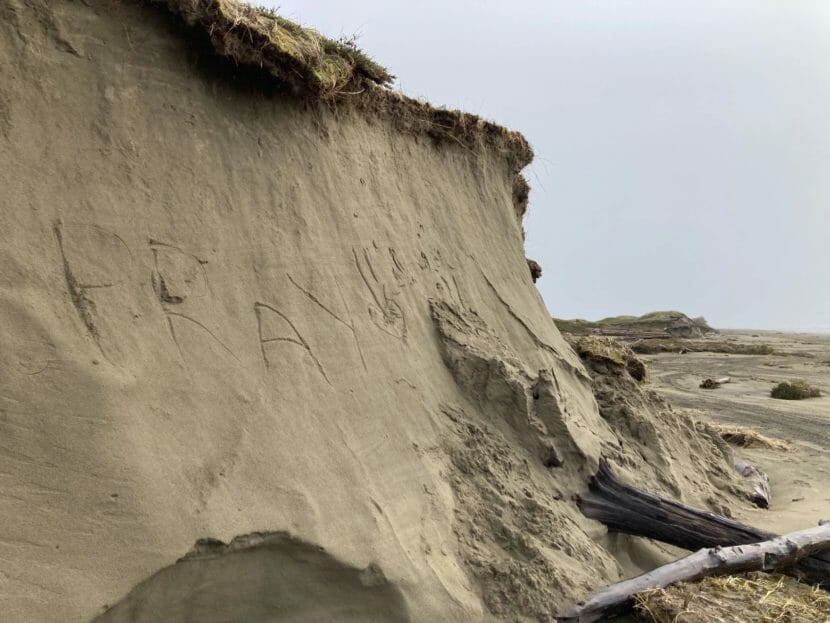
On the beach in Hooper Bay, Daniel Cernek, a middle school science teacher, is working to wrangle a few dozen of his students. It’s been less than a week since a powerful storm brought flooding and severe winds to the town of 1,300.
As part of his science class, Cernek wants his students to observe the coast and learn about erosion.
“You need to think back before the storm,” Cernek said. “When you drove down the beach, what was different between then and now?”
The students are on the beach south of the village where the storm surge was the strongest. In parts of this area, what was once a stretch of rolling sand dunes is now a flat floodplain. There used to be five rows of dunes. Now, there’s only one row here. In other places, they remain intact. The beach itself has also shrunk. Those dunes form a natural sea wall for the town. Without them, it’s left the town exposed.
Before the storm, Cernek took measurements of how far the water was from the dunes. On this field trip, he’s trying to gauge how things have changed.
“We’re going to get the GPS. They’ll record it on their paper, and we’ll use that to build a map that has the old coastline and the new coastline overlaid on each other,” Cernek said.
According to Cernek’s calculations, the storm eroded about 300 feet of coastline, bringing the water that much closer to town. The loss of Hooper Bay’s dunes has potentially serious consequences.
Emma Smith, a longtime Hooper Bay resident, drove her four-wheeler down to the beach after the storm to get a sense of the impact.
“That was traumatizing just by seeing how much our coastline has eroded,” Smith said. “There is not going to be enough protection for the village if water should be coming in from the Bering Sea. That’s really scary.”
Hooper Bay has minimal ground above sea level. The dunes have protected the village from high water. A 2014 assessment by the Alaska Division of Geological and Geophysical Surveys estimated that the coastline near Hooper Bay erodes about 5 feet every year. Floods like this accelerate that timeline.
The airport, which is only about a quarter mile from the shoreline, is the infrastructure that is most at risk of erosion over the next few decades. But more immediately, storm surges threaten the safety of the whole village. Although no one was injured or killed in the storm, the flood caused serious property damage and destroyed the homes of multiple families. Experts say that these storms are becoming more frequent due to climate change.
Tom Ravens, a professor at the University of Alaska Anchorage and an expert in coastal erosion, said that oceans can be an extremely destructive force.
“If you think about a wave building over, you know, hundreds or thousands of miles, those waves encapsulate just a ton of energy,” Ravens said.
Ravens said that Hooper Bay’s dunes likely made the flooding less severe than it otherwise could have been.
“The dunes can be considered like sacrificial elements, so there is value in rebuilding the dunes even if the next storm is going to take them out,” Ravens said. “The value is that they’re preventing the water from flowing from the ocean into the community.”
Mary Hoeschler, another lifelong resident of Hooper Bay, said that she was already concerned about what erosion along the coastline meant for the village. With the loss of the dunes, it’s hard for her to feel safe planning for her future in Hooper Bay.
“I wanted my kids to live here. I wanted to build them a house and live in Hooper Bay,” Hoeschler said. “But it feels like we have to move.”
On the beach, students were laughing and enjoying being outside of the classroom, rushing in and out of the waves. For them, at least right now, this moment is a learning experience and a chance to process the trauma of the past week. But for adults, it’s hard not to wonder what the loss of Hooper Bay’s dunes will mean for these students’ futures, and for the future of the town.
“I have no idea,” Hoeschler said. “This is just crazy and scary.”
